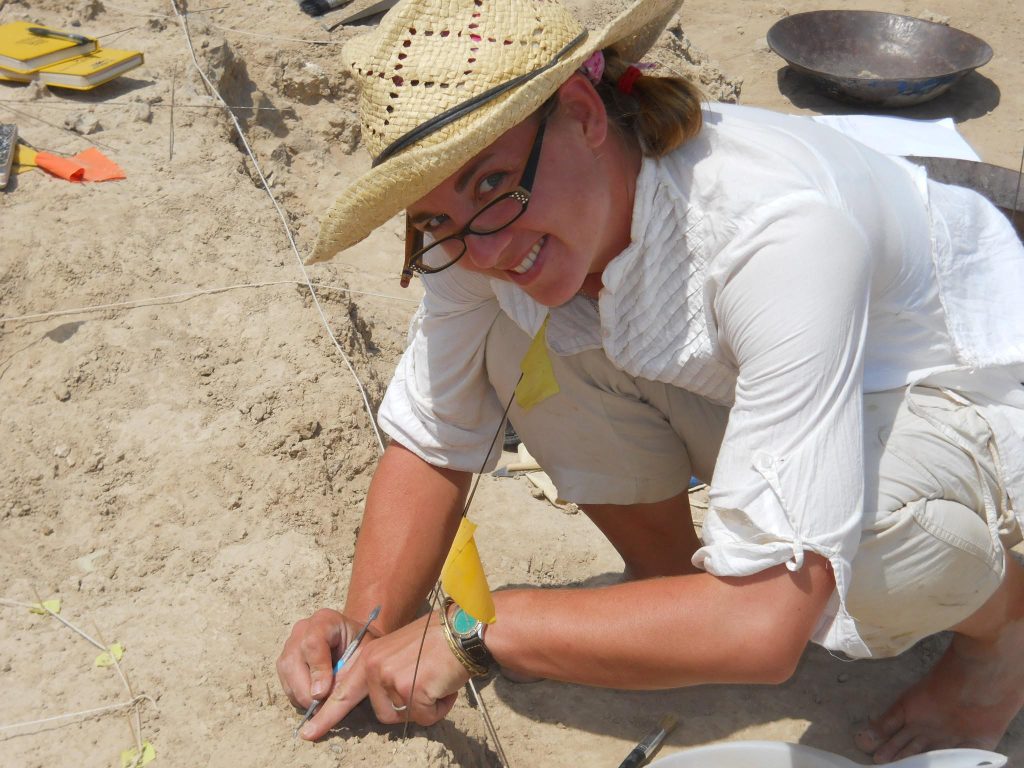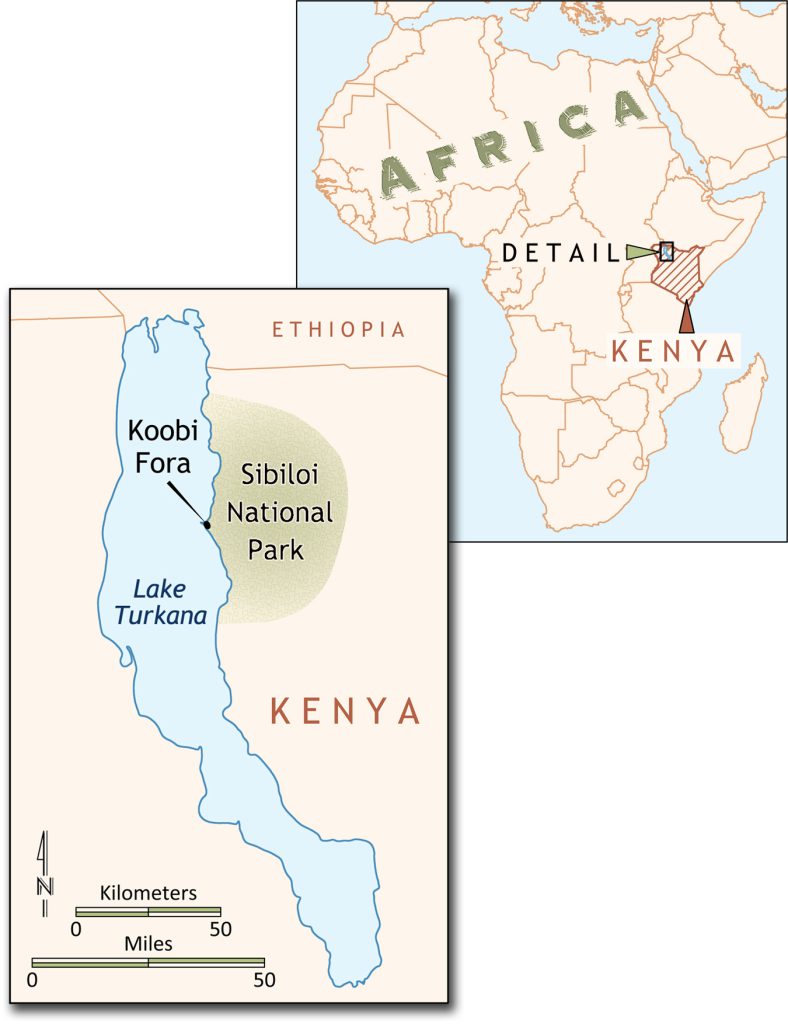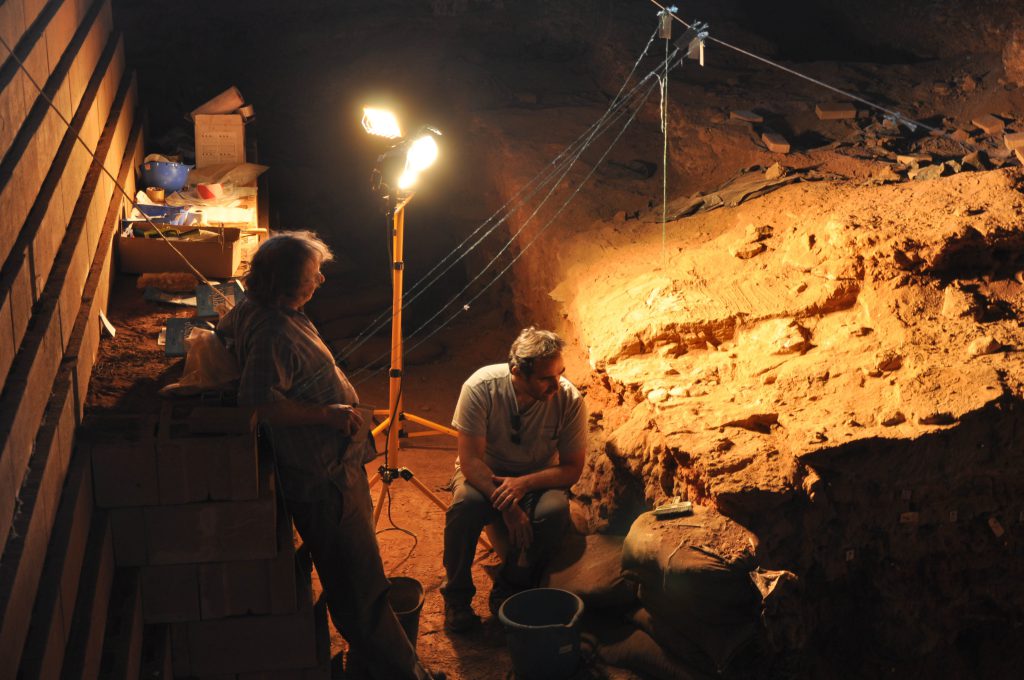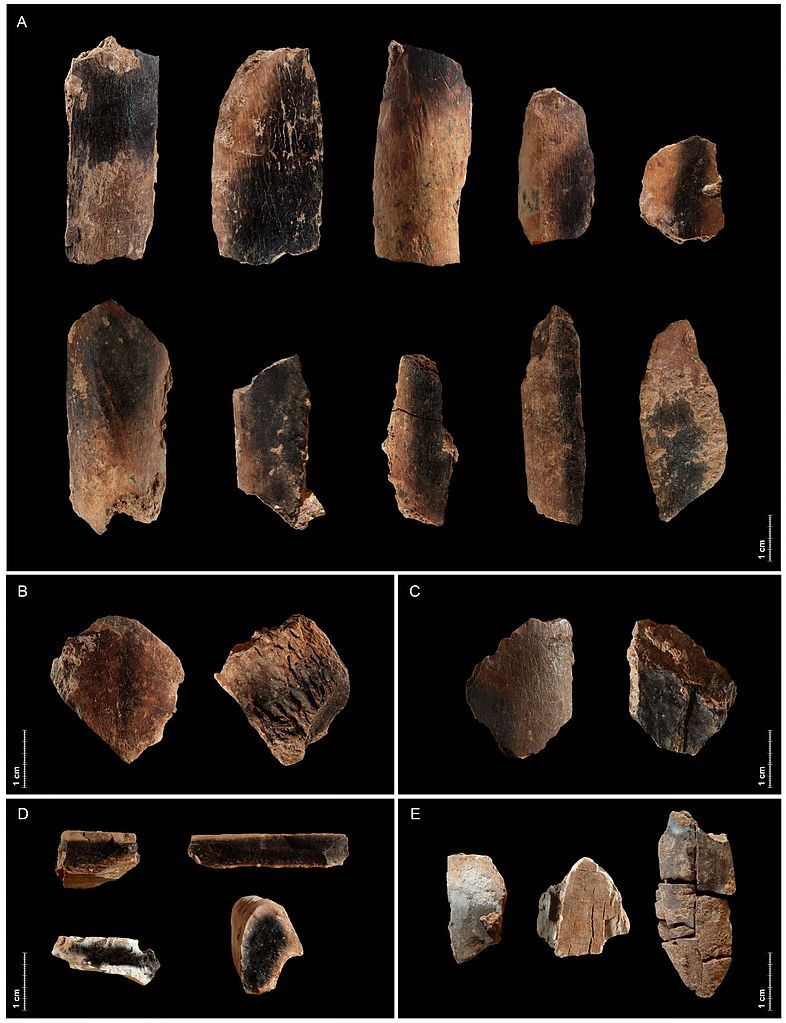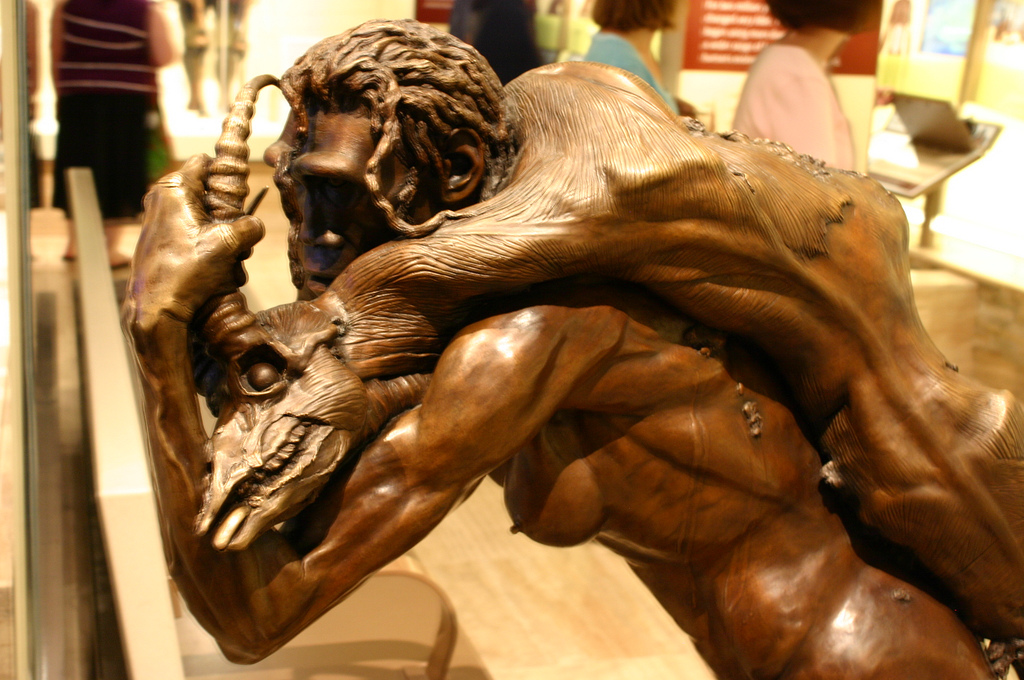Uncovering Ancient Clues to Humanity’s First Fires
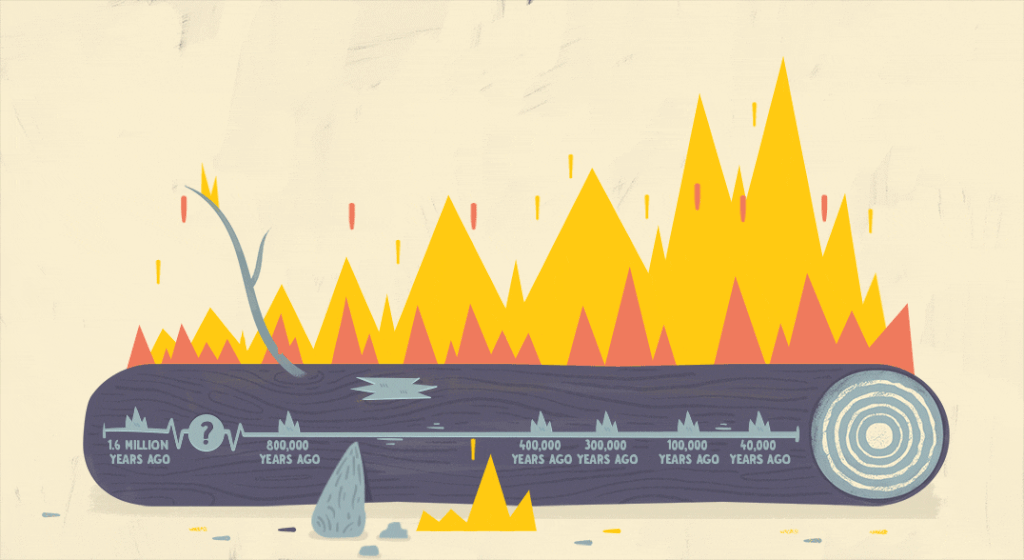
Each summer, archaeologist Sarah Hlubik treks rutted dirt tracks to a dry riverbed in Kenya, following, approximately, in the footsteps of ancient hominins who camped there about 1.6 million years ago. Those early people likely butchered animals and fashioned stone tools, and Hlubik, a graduate student at Rutgers University in New Brunswick, New Jersey, thinks they did so around a flickering campfire. On her summer expeditions, she collects bits of burned bone and soil samples in the hope of proving her case.
Her question is a basic one about a crucial early technology: When did humankind first put fire to work for them, using it regularly for heat and cooking? Hlubik and other archaeologists who sift through the long-cold ashes of fires past cannot say for sure. It probably wasn’t as early as 2 million years ago—but it almost certainly occurred by 300,000 years ago. That leaves a big gap, with plenty to investigate.
It’s a deceptively hard question to answer. “In order to find early fire, we have to work really, really hard,” says Michael Chazan, director of The Archaeology Centre at the University of Toronto. Evidence of fire is ephemeral: Its traces, in the form of ashes or baked soils, are usually eroded away by wind or water. Even when signs of potential burning are present, it can be surprisingly hard to understand their exact origin. Researchers recently determined that the “burned” darkened wood and reddened sediments found at a site in northern Germany, now a coal mine called Schöningen, were really colored by water exposure and soil decomposition, not ancient flames. Even if evidence for flames is more certain, it can be tricky to tell if the fire was the result of a natural blaze or a human-made spark, or if people harvested it from a nearby wildfire for their own use. Even harder to decipher is whether people were using those fires “regularly,” and whether that means every week, year, or decade.
The question gets at the very root of what it means to be human: Fire is one of the things that pushed human evolution along. Roasting foodstuffs meant a calorie-rich diet, which may have fueled our big brains into existence. Fire provides protection from predators and a warmth that may have allowed humankind to extend its geographical reach. Plus, tending a blaze and gathering around it could have helped shape us into the social animals we are now. Understanding when people mastered fire could help archaeologists figure out if and how it contributed to these major events in the evolution of the human body and mind. For example, did it really coincide with a jump in brain size, which would indicate it may have helped make us deep thinkers?
But to consider how fire impacted the development of hominins, researchers must first unearth the basics: the initial fleeting evidence of flames that were in any way tended or used by our ancestors. Based on about a half-dozen digs in Africa and the Middle East, researchers like Hlubik are pushing that first-fire date back to the most distant estimates—1.6 million to 800,000 years ago.
Hlubik was inspired to investigate her site, part of a larger archaeological area known as Koobi Fora, because of reddened, bowl-shaped patches, about a meter below the surface, that were first identified in the 1970s and 1980s in a nearby part of Koobi Fora. These look like what happens to the ground when a campfire heats and oxidizes iron in the soil, turning it rust-like.
To get to the site, Hlubik and her students in the Koobi Fora Field School drive to Sibiloi National Park. Then they count themselves lucky if they still have roads to traverse; often parts of the roadways are washed out during the rainy season, which can add a day to their travels. At the dig site, they camp in tents, dig wells for water, and use solar panels, supplemented by generators, for energy.
The landscape was a bit different when the original campers first occupied the place some 1.6 million years ago. They were likely Homo erectus, says Hlubik, though Homo habilis and Paranthropus boisei were also in the area. At that time, there was a river nearby. Hlubik speculates that hominins may have visited the region to collect nuts from the local palm trees.
Hlubik and other archaeologists have excavated around 5,000 artifacts from the site—mostly chips of bone or stone flakes. As part of their careful documentation process, the archaeologists precisely map where they find every fragment. If the hominins tended a fire, presumably they sat around it to cook, eat, chat, or work stone. And if so, they probably left behind garbage in the form of burned bone or stone chips—rather like the crushed beer cans or plastic utensils littering the borders of some modern campfires.
Back home in the lab, using infrared spectrometry to test about 800 bone fragments, Hlubik found that 40 were definitely burned and another 80 or so might have been exposed to flames. Those 40 burned bits are clustered together in a spot less than a meter across, which Hlubik suspects is where the hominins gathered by a hearth.
Still, it is possible the items might have been burned by natural blazes, unused and untended by people. It’s easy to get confused, especially if there isn’t a clear pattern to the remains, says Dennis Sandgathe, an archaeologist at Simon Fraser University in Burnaby, Canada. He notes that colleagues of his observed sites where bushes burned, naturally, in abandoned Incan settlements. “They looked for all the world like hearths,” he says. Hlubik points out that termite mounds, typically constructed in dead trees throughout Africa, Australia, and South America, can also burn.
But the changes that Hlubik sees to bone and the surrounding dirt mean that a fire burned in the same place for at least an hour or two, she says, ruling out fast-moving grass fires. And she says sediments from a tree-stump or termite-mound fire would look different: termite mounds contain passages, for example, which remain visible due to the different sediments that fill them over time. In contrast, tree-stump sediments would be more compacted. “I’m fairly confident we have at least one instance of fire [used by people] on the site,” she concludes, though she can’t say if the fire was started by the campers, or just tended by them.
If confirmed, Hlubik’s 1.6-million-year-old site would be the earliest case of human fire use, she says. But it is not the only site pushing fire use back a million years or more. Chazan, geoarchaeologist Francesco Berna of Simon Fraser University, and their colleagues have an ancient fire site at Wonderwerk Cave in South Africa.
Wonderwerk Cave has intermittently sheltered hominins since about 2 million years ago. Entering the cave today, archaeologists skirt the big stalagmite that has stood near the entrance for the last 35,000 years. The walls are adorned with ancient pictures of giraffes and hash marks as well as other designs in white, red, and black. The cave runs more than 100 meters deep and is about 3 meters high. “It’s basically like a subway tunnel,” says Chazan. Archaeologists found that hominins brought quartz, ochre, and other colored minerals, for mysterious and perhaps ritual purposes, into the back of the cave about 300,000 to 500,000 years ago. The late archaeologist Peter Beaumont of the McGregor Museum in Kimberley, South Africa, who did many excavations at the site between 1978 and 1996, had claimed there was evidence for fire in various spots, in 1.6- to 1.7-million-year-old layers. Chazan and others were skeptical.
The researchers didn’t notice any evidence of fire when they dug up one particular section, about 30 meters from the cave entrance, in 2005. They changed their minds about Beaumont’s claim in 2009, however, when they met at the Weizmann Institute of Science in Rehovot, Israel. Their goal was to examine layers of sediment from the cave, collected and preserved using a technique called micromorphology. They had cut out blocks of sediment from the cave floor and soaked them in resin to harden them. Then they trimmed off slices, mounted those on glass slides, and ground them to just 30 microns thick to observe under a microscope. Midway through the meeting, the geoarchaeologists in the room suddenly perked up. “Oh my God, that’s wood ash,” Chazan recalls them saying. “No, it can’t be.”
The researchers looked more closely and consulted with another expert. By the end of the day, they were reasonably convinced: There were 1-million-year-old fragments of burned bone as well as ash in Wonderwerk Cave. (The finding forced Chazan to reconsider a paper he was preparing, in which he had planned to argue that humankind didn’t use or light fires until about 400,000 years ago.)
At 30 meters deep into the cave, the burned area sits too far inside to be the site of a lightning strike. This has led the archaeologists to hypothesize that hominins collected flames from wildfires and brought them into the cave. But what the ash layer is missing so far is evidence of a structured fire where the cave denizens gathered, cautions Paul Goldberg, an emeritus professor at Boston University and one of the geoarchaeologists on the team. That evidence might take the form of a pit, reddened rock or soil overlaid by charcoal and ash, or a concentration of discarded tools and trash as Hlubik has seen in Koobi Fora. Further investigation is underway.
Despite the best efforts of Chazan, Hlubik, and others, many archaeologists remain skeptical that humankind tended flames at these early dates. Sandgathe says that for early sites like Wonderwerk and Koobi Fora, he’s just not convinced beyond a reasonable doubt. “At this point I’m fairly agnostic,” he says; for him, Hlubik’s “hearth” might still just have been a burning bush.
Possible early fire sites like Koobi Fora were on the docket at a 2015 meeting organized by Sandgathe and Berna in Sintra, Portugal, where archaeologists discussed fire and the genus Homo. [1] [1] Editor’s note: The 2015 conference “Fire and the Genus Homo” was sponsored by the Wenner-Gren Foundation, which publishes SAPIENS. Attendees agreed that they would really like to know when fire became such a regular tool that it influenced hominin evolution.
Hlubik has plans to investigate how widespread the use of fire might have been more than a million years ago. She wants to look beyond Koobi Fora to other digs in Eastern Africa and to artifacts currently stored in museums. By applying the techniques she has used in Kenya, such as infrared spectroscopy and micromorphology, which weren’t widespread until this century, she hopes to spot evidence of fire that others might have missed.
But pinning down “regular use” is a hard task. One of the earliest sites with evidence of persistent fire use is Qesem Cave in Israel, which hominins started using about 400,000 years ago. “The cave is full of wood ash,” says Ran Barkai, an archaeologist at Tel Aviv University in Israel. “We have tons of burned bones and burned flint items.” He believes the inhabitants were capable of lighting fires, though he does not yet have direct archaeological evidence of that. But even at Qesem, it’s hard to be sure if the cave users gathered around fires often, or only harvested a rare one once a century, notes Sandgathe; dating methods simply aren’t precise enough to tell.
Just because one culture tended, or even lit, fire, doesn’t mean the concept immediately caught on and warmed humankind forevermore. It’s possible that fire tending happened in fits and starts before it was cemented in human habits.
Sandgathe and his collaborator, archaeologist Harold Dibble of the University of Pennsylvania in Philadelphia, think that is what happened with Neanderthals who inhabited sites the pair have excavated in France, which date to between 100,000 and 40,000 years old. They found some layers of sediment containing ash and burned tools and bone, and some layers without. Oddly, it’s the more recent, coldest time periods when fire seems to be absent. They hypothesize that Neanderthals couldn’t make fire and that they had better access to it during warm periods when lightning strikes were frequent.
But their hypothesis begs the question: If Neanderthals couldn’t start fires, how did they survive the chill? “That’s a tough one,” admits Sandgathe. “Seventy-five thousand years ago, it was really bloody cold.” The average temperature was probably about 5 to 10 degrees Celsius colder than today, he says. Maybe the Neanderthals fashioned warm clothing, he muses, or perhaps they were just rather hairy.
Others doubt that Neanderthals’ fire usage really died away. “I’m pretty sure they knew how to make it,” says Hlubik. Another explanation for Sandgathe and Dibble’s findings, she speculates, is that Neanderthals might have had to rely on animal dung, instead of wood, for fuel during cold and relatively treeless periods. Perhaps they wanted to keep the stinky fumes of fires for cooking or toolmaking away from their home caves, and so they lit those fires farther afield—where the evidence more easily washed away, or hasn’t yet been found.
Andrew Sorensen, a Ph.D. student in archaeology at Leiden University in the Netherlands, is looking more directly at the question of whether these more recent peoples could make fire. “The only real, true way you can tell whether or not they are making it themselves is by looking for the tools they were using to make those fires,” he says.
Unfortunately, most tools for fire-starting, such as sticks to spin and create friction, are made of wood and are therefore unlikely to survive in the archaeological record. That leaves striking rocks, such as pyrite against flint, as the method Sorensen is most likely to find proof for among artifacts. There’s solid evidence, in a hand-grooved nodule of pyrite from Belgium, that some humans set fires this way around 13,000 years ago. Sorensen has been picking through rocks in museums looking for microscopic markings that might indicate the stones were used to strike fires, perhaps only once or twice before being discarded. He says he has examined several such tools from Neanderthals who inhabited southwest France about 50,000 years ago.
“Neanderthals were almost certainly making fire during the last glacial period,” says Sorensen, referring to a time about 100,000 to 35,000 years ago.
Regardless of when exactly humankind managed to make fire a regular presence in their lives, scientists agree it was a turning point in human evolution. Eventually, humankind hit a point of no return when fire became essential. Modern humans can’t do without it, whether to burn gasoline in our engines, warm our nearly hairless bodies, or cook porridge or steak.
Cooking, in particular, is widely seen as a crucial adaptation. It makes both meat and vegetables easier to chew, and frees up calories for digestion. The evolutionary biologist Richard Wrangham, at Harvard University in Cambridge, Massachusetts, has argued that cooking fires changed the course of human evolution. As evidence of our need for the flames, he points to research showing that modern women who follow an all or mostly raw food diet often don’t menstruate—something that’s clearly needed for species propagation.
Earlier hominins, of course, reproduced just fine in the cold. Wrangham suggests that the situation began to change with Homo erectus, who probably arrived on the scene about 1.9 million years ago. Its ancestors had big teeth to crush tough foodstuffs, large bellies to ferment those meals, and relatively small craniums. With Homo erectus, scientists see a shift to a taller and brainier hominin who spread across Africa, into Asia, and throughout parts of Europe. “What was it that made Homo erectus possible?” asks Hlubik. “There had to be something that happened.”
That something, she and Wrangham think, could have been fire control. The early fire dates creeping up on 2 million years ago could support that hypothesis, but other archaeologists say the evidence on the ground is thin.
“I love Richard Wrangham’s cooking hypothesis … it makes so much sense,” says Sandgathe. “Unfortunately, the empirical data don’t support it that well.” Even if the vast majority of Homo erectus fires left no traces, one ought to still see more than a half-dozen scattered sites if they were cooking enough to change their evolutionary course, he argues. Other researchers have suggested that instead of cooking, chopping food could have provided a similar caloric boost.
At the Portugal meeting, Israeli archaeologist Barkai offered an alternative cooking hypothesis that would explain why fire became widespread about 400,000 years ago in the region that’s now the Middle East. Before that time, Barkai says, elephants had occupied the area for hundreds of thousands of years and were likely a key food source. The pachyderms make a rich meal: They’re fattier than other animals, and those fat calories are readily available even if the meat is uncooked. Around 400,000 years ago, elephants mostly disappeared from the archaeological record, though a couple of accounts find possible evidence of elephants at later dates. It’s not certain why the great beasts vanished; maybe they were overhunted. Their disappearance coincided with the emergence of leaner hunters, Barkai has posited, and he argues it would have forced people to turn to leaner meals, such as fallow deer. Mastering fire and cooking that meat, Barkai argues, would have freed up enough calories to feed the hungry hominins.
The elephant hypothesis helps explain how early hominins might have fueled their bodies without fire, says Chazan. But the real situation was probably more complicated, adds Sandgathe. “I don’t think the option is as simple as just ‘elephants or fire’,” he says, pointing out that some hominins in places like Europe clearly managed to get enough calories from raw game other than elephants or mammoths.
While calorie-rich meals might have been a main driver for the adoption of fire, there are other benefits, from warmth to protection from predators. Tending a hearth also could have made a big difference in the evolution of social skills: People would have had to cooperate to manage and feed fires, and they perhaps socialized around the flames. “When you bring fire into a habitation, I think something pretty profound happens,” says Chazan. “It’s mesmerizing.”
But until the work of Hlubik and others gets more concrete, and more evidence of fire is unearthed, exactly when and where its use became commonplace, and how that changed human evolution, will remain under debate. “It is one of those great mysteries,” says Hlubik.
This article was republished on Scientific American.
































